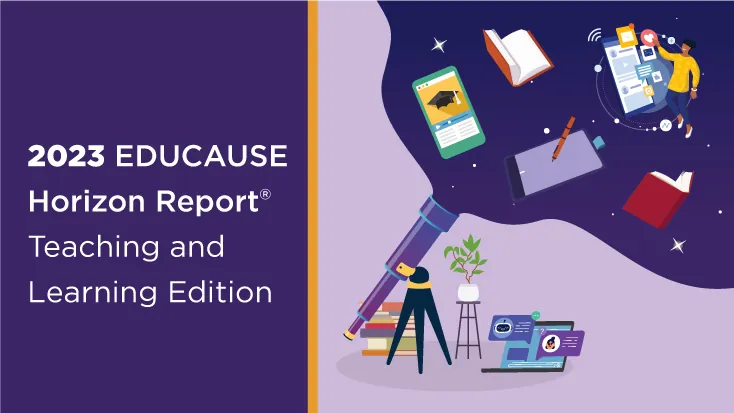Last month, EDUCAUSE released the 2023 EDUCAUSE Horizon Report. The report looks at the key trends in education and emerging practices shaping the future of global Higher Education teaching and learning. In this blog, we break down these trends and challenges for education and discuss the impact they are going to have on the Higher Education sector.

1. Social
Trends in Education:
Student demand for flexible and convenient learning modalities is increasing:
Post Covid-19 Pandemic it is evident that a ‘one size fits all’ approach to Higher Education is not going to work. There have been many unprecedented student & university challenges and it is widely reported that students are demanding a more flexible approach to teaching and learning than the traditional face-to-face model that many HEIs offer.
The focus on equitable and inclusive teaching and learning has expanded and intensified:
Last year, the National Education Opportunities Network described the current situation around equity and inclusion in Higher Education as a ‘crisis’. Evidence has shown that inequalities in Higher Education have been worsened by the recent pandemic. This presents significant challenges for education as there has been lower participation, more drop-outs, and poorer degree results for disadvantaged students. As a result, equitable and inclusive teaching and learning has become a top priority for students, academics and HEIs.
Microcredentials programs are gaining momentum and maturity:
Among other trends in education, Higher Education is becoming an increasingly expensive and inaccessible educational option for many and some are looking at microcredentials programs to fill the gap. Often these programs offer the kind of flexible and convenient learning experience that HE cannot, at a much more affordable price.
Impact:
With the number of challenges facing students on the rise – including financial and mental health struggles – students hoping to complete HE are increasingly only able to do so if flexible and convenient learning modalities are available. The perceived inaccessibility of single or traditional learning modalities is contributing to university challenges around enrollment and retention rates. As a result, a focus on equitable and inclusive teaching and learning should consider the accessibility of learning modalities.
Can your students access support or ask for help online? Does your institution have the resources to accommodate online or off-campus teaching events?
This may help protect HEIs against negative trends in education including the prediction that between now and 2025, participation of equity groups in education will decrease, and attainment and retention will fall. Microcredential programs are a great option for many students however, institutions need to ensure the proper standards are in place to improve education quality and student satisfaction.
Technology can make a big impact here. Implementing systems that are built for Hybrid Learning, can make this transition seamless for HEIs. Similarly, using sophisticated data and learning analytics, HEIs can ensure that student success and engagement remains highs across all learning modalities. This is particularly useful in relation to equity groups and at-risk students.
2. Technological
Trends in Education:
The potential for AI to become mainstream is growing:
The growth of AI technologies has been exponential in recent years. The EDUCAUSE Horizon report indicates that AI can help HEIs address growing university challenges around enrollment, retention, and financial aid allocation.
The online versus face-to-face dichotomy is being disrupted:
As a result of the Covid-19 pandemic and resulting demand for multi-modal and Hyflex learning environments, many HEIs adopted a modal of teaching and learning that combines both online and face-to-face. This disrupts the traditional view that courses should be delivered in an either/or scenario.
Low- and no-code technologies (LCNC) that simplify complex processes are enabling more people to create digital content:
As part of a rise in digital transformation across Higher Education campuses, one necessary element is to make data more accessible to all and to build a data culture within institutions. LCNC technologies can play an instrumental role in achieving this.

Impact:
One particularly interesting emerging trend in education is the growth of AI technologies. This has the potential to provide a more personalised Higher Education experience for students from enrollment through to graduation. Recent student surveys have highlighted how important a personalised, connected experience is becoming for students. This is not only for their perceptions of Higher Education but for their academic and personal success as well. AI can assist strategies such as data-driven academic advising in providing more proactive and effective support for students and address wider university challenges.
The widespread adoption of Hyflex teaching and learning modalities can assist in making HE more accessible for all, combating the rising cost of living for students and improving enrollment and retention issues at HEIs. HEIs should not overlook the impact that multimodal technologies can have in creating a positive experience for staff and students.
The rise of LCNC technologies is making it easier for all staff and students to engage with and participate in digital creation. As the EDUCAUSE Horizon report indicates, this creates “opportunities for the democratization of app development” and improves digital and data literacy for all. This is crucial to creating an institutional data culture within your digital transformation.
3. Economic
Trends in Education:
Affordability and ROI are impacting potential students’ decisions to enroll in postsecondary education:
Adding to existing challenges for education, the last number of years has seen a growing enrollment crisis in Higher Ed. Not only is the rising cost of living impacting students, but there is growing concern around the Return-on-Investment of Higher Education. This is especially true for institutions who require significant enrollment fees but offer little flexibility to students around learning.
As funding for public higher education declines, institutions are expected to do more with less:
Impacted by decreasing investment and falling retention and enrollment rates, HEIs are struggling to maintain resources and remain sustainable. This impacts the quality of learning, support and resources that institutions can offer staff and students. Many institutions have begun their ‘digital transformation’ journey and put in place climate sustainability goals. Decreasing investment and budget availability, puts much of this at-risk.
The need and demand for lifelong, workplace learning are increasing:
As technology continues to advance at such a significant rate, workers in many industries are actively looking to enhance their workplace skills and knowledge. As seen by the growth of microcredentials, there is increasing demand for education institutions to provide affordable, digitally accessible and relevant training and learning programs.
Impact:
The growing concerns among students around the affordability and ROI of higher education, is increasing the demand for HyFlex education options, more workplace learning opportunities and improved employability rates. Failure to meet the demand will only result in lower student enrollments and further student drop-outs at higher education level. This will only add to university challenges, putting more financial strain on universities, making it harder to serve and retain the students they do have. Evidence is telling us that many students need more support from their university to make higher education a viable option.
Data driven academic advising and personal tutoring has been shown to enable more effective, personalised communications with students and provide more targeted support.
In addition, with less funding available many institutions will be unable to achieve their climate goals, especially ‘net-zero’ goals. This delays the higher education industry in reducing its environmental impact. HEIs need to adapt to the evolving concerns and demands of students, as cost effectively as possible, to ensue higher education remains an attractive and sustainable option going forward.

4. Environmental
Trends in Education:
Climate change is increasingly impacting our daily lives:
It is no secret that climate change is one of the biggest crises’ facing the world today. To assist in the fight against climate change, all industries have their part to play. This is extremely relevant for such a large, global industry such as higher education. Higher education has the ability and responsibility to be a leader in sustainability initiatives and to educate the masses about climate change, environmental issues and improving sustainability.
Environmental issues are being integrated into academic programs and institutional operations:
Recognising their role in such a global industry, many HEIs have begun integrating their sustainability values into academic programs and institutional operations. This means making environmental education an integral part of learning at your institution, in the same way that research and ethics would be.
Technology is behind the curve on reducing its environmental impact:
The effort to reduce carbon emissions at HEIs has traditionally focused on energy efficiency – lighting and heating, transport emissions, and water consumption. However, technology has its own carbon footprint. As institutions embark or advance on their ‘digital transformation’ journey, they should take into consideration the digital footprint and cost of the new applications, software and devices they introduce.
Impact:
Whether HEIs realise it or not, the very process of digital and data transformation is unquestionably linked to sustainability transformation. If they are not already, HEIs should be making every decision along their digital transformation journey with sustainability in mind. The goal should be to become a digitally and data effective institution and achieve net-zero, carbon emissions.
There are systems that can assist institutions in their sustainability journey. Technology such as space utilisation software and data-driven scheduling can significantly reduce an institutions wasted emissions instantly.
5. Political
Trends in Education:
Governments are leveraging disinformation and propaganda:
As such large, global institutions, HEIs are unable to remain untouched from politics and political conflict. One of the growing concerns around AI, social media and technology is the rise in disinformation and propaganda. Here, HEIs play a role in educating staff and students on digital and information literacy. Additionally, HEIs need to address trends such as rising political bias and academic conflict among staff and students within their institution.
Nationalism is rising across the world:
The EDUCAUSE Horizon report highlights that in recent years, political uncertainty and polarization has led to Academic freedom, public investment in higher education, and governance and management, “all being threatened”. We have seen Diversity, Equality and Inclusion programs at many institutions in the US already being defunded and impacted.
Political party conflict is increasingly blocking decision making and action in the U.S. political system:
In the US, continued political party conflict may lead to delays in higher education policy making and uncertainty over the future of many programs, grants and resources needed for institutional operation. This adds to existing university challenges and disruptive trends.

Impact:
Political issues can have a huge impact on HEIs. From funding, to academic freedom, to staff and student safety. HEIs should be paying close attention to any political unrest, uncertainty and polarization. It is important that Higher Education Institutions do not underestimate the importance of upholding and promoting the values and principles it was built on such as Academic Freedom and DEI.
The Higher Education space has already seen incredible changes over the last few years however, it appears these transformations will continue. Major developments in technology, AI, climate change and student expectations are on the way. As a result, HEIs need to try stay ahead of the curve to be sustainable.
The key takeaways from this report are that institutions need to adapt to the changing needs of their students, circumstances and environment. Overcoming the above challenges for education will require strategic planning and the adoption of innovative technologies.
For more check out our Top Education Solutions for 2023 here.








